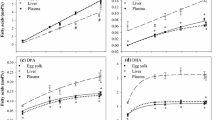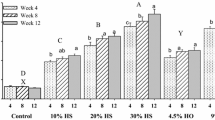Abstract
The effect of dietary CLA and n−3 PUFA on hepatic TAG accumulation, histopathology, and FA incorporation in lipid classes by laying chickens was investigated. One hundred twenty 30-wk-old single-comb white leghorn laying hens were distributed randomly to four treatments (3 replications of 10 birds) and were fed diets containing CLA and animal fat (Diet I), 18∶3n−3 (Diet II), or long-chain n−3 FA (Diet III). A sunflower oil (n−6 FA)-based diet was the control. Feeding Diet I resulted in an increase in hepatic total lipids (P<0.05). The liver TAG content was 32.2, 18.9, 29.4, and 18.7 mg/g for hens fed Diet I, Diet II, Diet III, and the control diet, respectively (P<0.05). The serum TAG was lowest in bilds fed Diet II (P<0.05). Diet I resulted in an increase in the total number of fat vacuoles and lipid infiltration in hepatocytes (P<0.05). The number of cells with 75% or higher lipid vacuolation was observed only in birds fed Diet I. Feeding diets containing CLA resulted in an increase in the content of the c9,t11 CLA isomer in liver TAG and PC (P<0.05). No difference was observed in the CLA concentration of hepatic PE fractions. The content of DHA (22∶6n−3) was higher in the TAG, PC, and PE of hens fed Diet II and Diet III than Diet I and the control (P<0.05). Feeding CLA resulted in an increase in total saturated FA in the TAG and PC fractions (P<0.05). Long-term feeding of CLA in laying birds leads to an increase in liver TAG and may predispose birds to fatty liver hemorrhagic syndrome.
Similar content being viewed by others
Abbreviations
- FLHS:
-
fatty liver hemorrhagic syndrome
References
Laidlaw, M., and Holub, B.J. (2003) Effects of Supplementation with Fish Oil-Derived n−3 FA and γ-Linolenic Acid on Circulating Plasma Lipids and Fatty Acid Profiles in Women, Am. J. Clin. Nutr. 77, 37–42.
Nair, S.D.S., Leitch, J.W., Falconer, J., and Garg, M.L. (1997) Prevention of Cardiac Arrhythmia by Dietary (n−3) Polyunsaturated Fatty Acids and Their Mechanism of Action, J. Nutr. 127, 383–393.
Pariza, M.W., Park, Y., and Cook, M.E. (2001) The Biologically Active Isomers of Conjugated Linoleic Acid, Prog. Lipid Res. 40, 283–298.
Cook, M.E., Miller, C.C., Park, Y., and Pariza, M.W. (1993) Immune Modulation by Altered Nutrient Metabolism: Nutritional Control of Immune-Induced Growth Depression, Poult. Sci. 72, 1301–1305.
Palacios, A., Piergiacomi, V., and Catala, A. (2003) Antioxidant Effect of Conjugated Linoleic Acid and Vitamin A During Nonenzymatic Lipid Peroxidation of Rat Liver Microsomes and Mitochondria, Mol. Cell. Biochem. 250, 107–113.
Fritsche, J.R., Rickert, H., Steinhart, M.P., Yurawecz, M.M., Mossaba, N., Roach, J.A.G., Kramer, J.K.G., and Ku, Y. (1999) Conjugated Linoleic Acid (CLA) Isomers: Formation, Analysis, amounts in Foods and Dietary Intake, Fett/Lipid 101, 272–276.
Ha, Y.L., Grimm, N.K., and Pariza, M.W. (1989) Newly Recognized Anticarcinogenic Fatty Acids: Identification and Quantification in Natural and Processed Cheeses, J. Agric. Food Chem. 37, 75–81.
Cherian, G. (2002) Lipid Modification Strategies and Nutritionally Functional Poultry Foods. Food Science and Product technology, Ch. 4 in Food Science and Product Technology (Nakano, T., and Ozimek, L. eds.), pp. 77–92, Research Sign Post, Trivandrum. India.
Squires, J., and Leeson, S. (1998) Etiology of Fatty Liver Syndrome in Laying Hens, Br. J. Vet. Med. 144, 602–609.
Bean, L.D., and Leeson, S. (2003) Long-Term Effects of Feeding Flaxseed on Performance and Egg Fatty Acid Composition of Brown and White Hens, Poult. Sci. 82, 388–394.
Van Elswyk, M.E., Hargis, B.M., Williams, J.D., and Hargis, P.S. (1994) Dietary Menhaden Oil Contributes to Hepatic Lipidosis in Laying Hens, Poult. Sci. 73, 653–662.
Cherian, G., Holsonbake, T.B., Goeger, M.P., and Bildfell, R. (2002) Dietary Conjugated Linoleic Acid Alters Yolk and Tissue Fatty Acid Composition and Hepatic Histopathology of Laying Hens, Lipids 37, 751–757.
Badinga, L., Selberg, K.T., Dinges, A.C., Comer, C.W., and Miles, R.D. (2003) Dietary Conjugated Linoleic Acid Alters Hepatic Lipid Content and Fatty Acid Composition in Broiler Chickens, Poult. Sci. 82, 111–116.
Folch, J., Lees, M., and Sloane-Stanley, G.H. (1957) A Simple Method for the Isolation and Purification of Total Lipids from Animal Tissues, J. Biol. Chem. 226, 497–507.
Cherian, G., and Sim, J.S. (1992) Preferential Accumulation of n−3 Fatty Acids in the Brain Tissue of Chicks from n−3 Fatty Acid Enriched Eggs, Poult. Sci. 71, 1658–1668.
Steel, R.G.D., and Torrie, J.H. (1980) Principles and Procedures of Statistics: A Biometrical Approach, 2nd edn., McGraw-Hill, Toronto.
Belury, M.M., and Kempa-Stezko, A. (1997) Conjugated Linoleic Acid Modulates Hepatic Lipid Composition in Mice, Lipids 32, 199–204.
Twibell, R.G., Watkins, B.A., and Brown, P.B. (2001) Dietary Conjugated Linoleic Acids and Lipid Source Alter Fatty Acid Composition of Juvenile Yellow Perch, J. Nutr. 131, 2322–2328.
Clément, L., Poirier, H., Niot, I., Bocher, V., Guerre-Millo, M., Krief, K., Staels, B., and Besnard, P. (2002) Dietary trans-10,cis-12 Conjugated Linoleic Acid Induces Hyperinsulinemia and Fatty Liver in the Mouse, J. Lipid Res. 43, 1400–1409.
Butler, E.J. (1976) Fatty Liver Disease in the Domestic Fowl—A Review, Avian Pathol. 5, 1–14.
Du, M., Ahn, D.U., and Sell, J.L. (1999) Effect of Dietary Conjugated Linoleic Acid on the Composition of Egg Yolk Lipids, Poult. Sci. 78, 1639–1645.
Raes, K., Huyghebaert, G., Smet, S.D., Nollet, L., Arnouts, S., and Demeyer, D. (2002) The Deposition of Conjugated Linoleic Acids in Eggs of Laying Hens Fed Diets Varying in Fat and Fatty Acid Profile, J. Nutr. 132, 182–189.
Author information
Authors and Affiliations
Corresponding author
About this article
Cite this article
Cherian, G., Goeger, M.P. Hepatic lipid characteristics and histopathology of laying hens fed CLA or n−3 fatty acids. Lipids 39, 31–36 (2004). https://doi.org/10.1007/s11745-004-1198-2
Received:
Revised:
Accepted:
Issue Date:
DOI: https://doi.org/10.1007/s11745-004-1198-2




